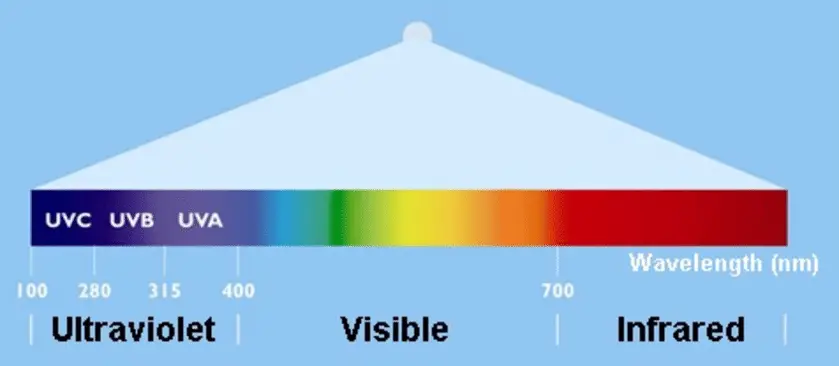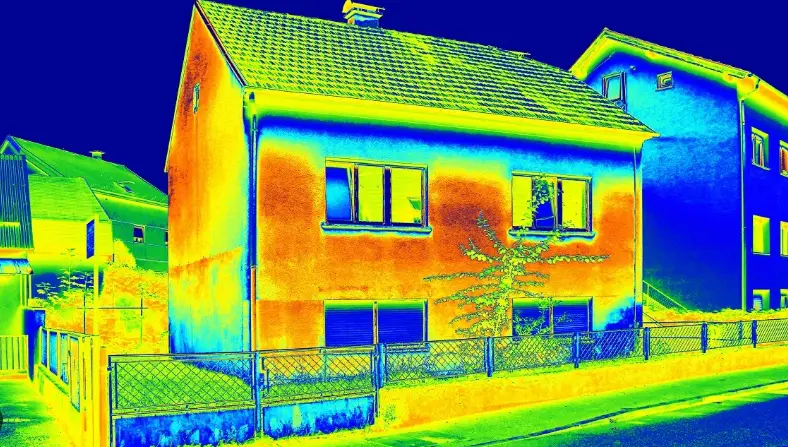Electromagnetic radiation encompasses a broad spectrum of waves, each characterized by its unique properties and effects. Among these, infrared and ultraviolet radiation hold significant importance due to their diverse applications and effects on our daily lives. Despite being on opposite ends of the visible light spectrum, both types of radiation are invisible to the human eye but integral to various technological and natural processes.
Infrared radiation is a type of electromagnetic radiation whose wavelength is longer than visible light but shorter than microwaves. It is primarily known for its heat-producing properties, as it is emitted by objects based on their temperature. In contrast, ultraviolet radiation has shorter wavelengths than visible light and is known for its ability to cause chemical reactions, such as those leading to sunburn. The fundamental difference between these two lies in their wavelength, energy levels, and their interactions with organic and inorganic matter.
Both infrared and ultraviolet radiation are vital to several fields, ranging from medical therapies and daily technological devices to critical scientific research. Their unique characteristics enable them to be used in various applications that impact environmental, medical, and technological advancements.

Infrared Radiation
Basics of Infrared
Definition and Characteristics
Infrared radiation (IR) is a type of electromagnetic radiation that lies between the visible spectrum and microwaves in the electromagnetic spectrum. It is characterized by wavelengths longer than visible light but shorter than those of microwaves. This radiation is not visible to the human eye but can be felt as heat.
Wavelength Range
The wavelength of infrared radiation ranges from about 700 nanometers (nm) to 1 millimeter (mm). This range is divided into three categories: near-infrared (0.7 to 1.4 µm), mid-infrared (1.4 to 3 µm), and far-infrared (3 µm to 1 mm).
Sources of Infrared
Natural and Artificial Sources
Infrared radiation is emitted by all objects that have a temperature above absolute zero. Natural sources include the sun, fire, and living organisms. Artificial sources of infrared include lamps, heaters, lasers, and other devices designed to emit IR for various applications.
Applications of Infrared
Everyday Uses
- Remote Controls: Most remote controls for electronic devices use infrared signals to communicate with the device.
- Thermal Imaging: Cameras that detect IR radiation can visualize heat differences in the environment, useful in security systems.
Industrial and Scientific Applications
- Spectroscopy: Infrared spectroscopy helps in identifying materials by analyzing the wavelengths of the IR radiation they absorb.
- Weather Forecasting: Satellites use infrared sensors to monitor cloud patterns and surface temperatures.
Health Effects
Benefits to Health
- Therapeutic Heating: Infrared lamps are used to provide direct warmth to areas of the body, helping to alleviate muscle pain.
- Improved Circulation: Exposure to infrared radiation may help improve blood circulation, enhancing tissue oxygenation.
Potential Risks
- Skin Burns: Prolonged exposure to high levels of infrared can cause burns similar to thermal burns from heat.
- Eye Damage: Intense infrared radiation can damage the eyes, necessitating protective eyewear in high-risk environments.
Ultraviolet Radiation
Basics of Ultraviolet
Definition and Characteristics
Ultraviolet (UV) radiation is a form of electromagnetic energy with wavelengths shorter than visible light but longer than X-rays. Unlike infrared, UV radiation can have chemical effects on the substances it interacts with.
Wavelength Range
The UV spectrum ranges from 10 nm to 400 nm and is commonly divided into UV-A (315 to 400 nm), UV-B (280 to 315 nm), and UV-C (100 to 280 nm).
Sources of Ultraviolet
Natural and Artificial Sources
Natural sources of UV radiation include the sun, which is the most significant source of natural UV radiation on Earth. Artificial sources include black lights, germicidal lamps, and UV lasers, which are used in a variety of applications.
Applications of Ultraviolet
Medical and Health Uses
- Sterilization: UV light is used to sterilize medical instruments and hospital environments.
- Vitamin D Synthesis: Exposure to UV-B helps the human skin produce vitamin D, essential for bone health.
Industrial Applications
- Water Purification: UV light is used to purify drinking water and wastewater by killing harmful microorganisms.
- Photolithography: In the semiconductor industry, UV light is used to etch microcircuits on silicon chips.
Health Effects
Health Benefits
- Skin Conditions: Controlled exposure to UV-B is used to treat skin conditions such as psoriasis and eczema.
- Mood Improvement: Exposure to sunlight, including its UV components, can improve mood and alleviate symptoms of seasonal affective disorder (SAD).
Risks and Protections
- Skin Cancer: Excessive exposure to UV radiation increases the risk of skin cancers.
- Protective Measures: Sunscreens, clothing, and sunglasses are recommended to protect against harmful UV exposure.

Comparing Infrared and Ultraviolet
Key Differences
Wavelength and Energy
Infrared and ultraviolet light differ significantly in their wavelengths and the energy they carry. Infrared light, with longer wavelengths ranging from about 700 nanometers to 1 millimeter, is less energetic but can penetrate deeper into materials and biological tissues. This allows infrared to transfer heat effectively, which is why it feels warm to the skin. In contrast, ultraviolet light has much shorter wavelengths, from 10 to 400 nanometers, carrying enough energy to break chemical bonds. This makes UV radiation both a powerful and potentially hazardous form of energy.
Interaction with Matter
The interaction of these radiations with matter also highlights their differences. Infrared radiation interacts primarily through vibrational and rotational modes of molecules, which leads to heating effects. Ultraviolet radiation, however, can initiate photochemical reactions, causing fluorescences in materials or sunburns in human skin due to DNA damage in cells.
Impact on Health
Comparative Analysis of Health Impacts
Infrared radiation is generally beneficial in controlled doses, promoting circulation and muscle relaxation, but excessive exposure can lead to thermal injuries and even permanent eye damage. On the other hand, ultraviolet radiation plays a crucial role in vitamin D synthesis, which is vital for bone health. However, its energy can also cause severe skin burns, accelerate skin aging, and increase the risk of skin cancer. The health impacts of UV radiation are more severe due to its potential to cause both acute and chronic health issues.
Technological Uses
Different Applications in Technology
The applications of infrared and ultraviolet radiation in technology are vast and varied:
- Infrared Technology: Used in night vision equipment, thermal imaging cameras, and remote controls. It’s also integral in various scientific instruments for measuring and observing thermal properties.
- Ultraviolet Technology: Predominantly used in sterilization processes and water purification systems. UV lamps are also essential in photolithography, a process used to manufacture electronic circuits and microprocessors.
Safety Measures
Infrared Safety
Ensuring safety when using infrared technology involves several guidelines and precautions:
- Limit Exposure: Avoid prolonged exposure to infrared sources to prevent thermal burns.
- Protective Gear: Use appropriate eye protection, such as infrared goggles, when around intense infrared sources.
- Regulation of Devices: Ensure that infrared emitting devices comply with safety standards to prevent accidental overexposure.
Ultraviolet Safety
Ultraviolet radiation requires stringent protective measures due to its potential health risks:
- Sunscreen: Apply broad-spectrum sunscreen that blocks both UV-A and UV-B rays to protect against sunburn and skin cancer.
- Protective Clothing: Wear long-sleeved shirts, trousers, and wide-brimmed hats to cover as much skin as possible.
- Eye Protection: Sunglasses or shields that block 99% to 100% of UV rays are essential to protect the eyes.
Frequently Asked Questions
What is Infrared Radiation?
Infrared radiation refers to electromagnetic waves with longer wavelengths than visible light but shorter than microwaves. It is commonly associated with heat, as it is emitted by all objects that have temperature, thus being integral to thermal imaging and many heating applications.
What is Ultraviolet Radiation?
Ultraviolet radiation consists of electromagnetic waves with wavelengths shorter than visible light. It plays a crucial role in various biochemical processes and is notable for its use in sterilization and fluorescent lighting, despite its potential to cause skin damage.
How do Infrared and Ultraviolet Radiation Differ?
The primary difference between infrared and ultraviolet radiation lies in their wavelengths and the effects they have on matter. Infrared radiation, with its longer wavelengths, primarily affects the thermal state of objects it interacts with, while ultraviolet radiation, with shorter wavelengths, is more energetic and can initiate chemical reactions.
What are the Uses of Infrared Technology?
Infrared technology is widely used in security, astronomy, and health industries. It allows for night vision, thermal imaging, and even remote temperature sensing, highlighting its versatility and importance in modern technology.
What are the Uses of Ultraviolet Technology?
Ultraviolet technology is crucial in medical therapies, water sterilization, and the creation of fluorescent effects. It’s also used extensively in scientific research and environmental monitoring, showcasing its broad range of applications.
Conclusion
Infrared and ultraviolet radiation, though part of the same electromagnetic spectrum, serve distinct purposes and exhibit different properties that make them valuable to various scientific and practical fields. Their unique characteristics allow them to contribute significantly to technological advancements and environmental management.
As we continue to explore and harness the potential of both infrared and ultraviolet radiation, understanding their differences and applications not only enhances our technological capabilities but also improves our approach to health and safety in utilizing these powerful forms of energy.
